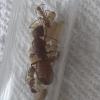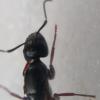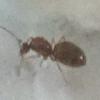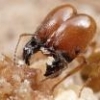- Formiculture.com
- Forums
- Gallery
- Members
- Member Map
- Chat

Massachusetts Anting Thread
Started By
Nathant2131
, Mar 22 2017 12:43 PM
massachusetts new england new england nuptial flights massachusetts nuptial flights massachusetts ants massachusetts thread new england ants new hampshire new hampshire ants new hampshire nuptial flights conneticut ants connecticut nuptial flights ma ct ri nh me vt maine maine ants
2124 replies to this topic
#901
 Offline
-
Posted October 3 2017 - 2:44 PM
Offline
-
Posted October 3 2017 - 2:44 PM
Quick question, when should I hibernate my colonies?
#902
 Offline
-
Posted October 3 2017 - 2:51 PM
Offline
-
Posted October 3 2017 - 2:51 PM
Quick question, when should I hibernate my colonies?
There's no staple time honestly, but you can now if you want. Right about now is when I hibernated my Lasius queens, and when I took them out in March they began to produce healthy colonies.
#903
 Offline
-
Posted October 3 2017 - 2:54 PM
Offline
-
Posted October 3 2017 - 2:54 PM
There's no staple time honestly, but you can now if you want. Right about now is when I hibernated my Lasius queens, and when I took them out in March they began to produce healthy colonies.Quick question, when should I hibernate my colonies?
Should I feed them at all before hibernation? (I just caught then recently)
#904
 Offline
-
Posted October 3 2017 - 3:18 PM
Offline
-
Posted October 3 2017 - 3:18 PM
There's no staple time honestly, but you can now if you want. Right about now is when I hibernated my Lasius queens, and when I took them out in March they began to produce healthy colonies.Quick question, when should I hibernate my colonies?
Should I feed them at all before hibernation? (I just caught then recently)
Yeah I would do that just to be safe. Remember all they need is water during hibernation.
- noebl1 likes this
#905
 Offline
-
Posted October 5 2017 - 11:57 AM
Offline
-
Posted October 5 2017 - 11:57 AM
Noooooooooooo! Today at my school we had a fire drill, and when we were heading back I saw a Ponera queen. Just when I bent over to snatch it, a kid stepped right on top of her (not on purpose he just didn't see it).
Things currently flying around here:
Crematogaster
Lasius
Ponera
Things currently flying around here:
Crematogaster
Lasius
Ponera
- Nathant2131 likes this
#906
 Offline
-
Posted October 5 2017 - 2:32 PM
Offline
-
Posted October 5 2017 - 2:32 PM
aw, that's sad. I hope you catch a ponera queen soon!
Also, are ants actually still flying?
Hawaiiant (Ben)
Keeper of
Miniature Labradoodle
Baby Wolf Spider
Mud Dauber wasp larvae
Ochetellus Glaber
Solenopsis Geminata
Brachymyrmex Obscurior
Cardiocondyla Emeryi
Tetramorium Bicarinatum
Plagiolepis Alluaudi
Anoplolepis Gracilipes
Technomyrmex Difficilis
Pheidole Megacephala
Aholehole fish
Cowrie snail
Sea Fan Worm
100+ sea squirts
Tree seedlings
Ghost Crab
Day Gecko
Small Fat Centipede
Endemic Lacewing larva
Vernal Pool shrimps
Keeper of
Miniature Labradoodle
Baby Wolf Spider
Mud Dauber wasp larvae
Ochetellus Glaber
Solenopsis Geminata
Brachymyrmex Obscurior
Cardiocondyla Emeryi
Tetramorium Bicarinatum
Plagiolepis Alluaudi
Anoplolepis Gracilipes
Technomyrmex Difficilis
Pheidole Megacephala
Aholehole fish
Cowrie snail
Sea Fan Worm
100+ sea squirts
Tree seedlings
Ghost Crab
Day Gecko
Small Fat Centipede
Endemic Lacewing larva
Vernal Pool shrimps
#907
 Offline
-
Posted October 6 2017 - 12:49 PM
Offline
-
Posted October 6 2017 - 12:49 PM
Parasitic Lasius is flying.
- noebl1, Connectimyrmex and Nathant2131 like this
#908
 Offline
-
Posted October 6 2017 - 1:34 PM
Offline
-
Posted October 6 2017 - 1:34 PM
I picked up a bunch of these to play with (though link on site may be out of stock): http://www.formicult...m-and-outworld/
I like the size for holding test tubes, and hope to get my current colonies into these as will make feeding easier. I may try to combine the two small P. imparis colonies i have using one as well.
No flights by me for a bit, or I somehow missed them. Not many flights left for here this season ![]()
- Nathant2131 likes this
#909
 Offline
-
Posted October 6 2017 - 2:53 PM
Offline
-
Posted October 6 2017 - 2:53 PM
Serious illuminati stuff right here: I just found LIVE Tetramorium alates in a spider web!
- rdurham02 and Aquaexploder like this
Hawaiiant (Ben)
Keeper of
Miniature Labradoodle
Baby Wolf Spider
Mud Dauber wasp larvae
Ochetellus Glaber
Solenopsis Geminata
Brachymyrmex Obscurior
Cardiocondyla Emeryi
Tetramorium Bicarinatum
Plagiolepis Alluaudi
Anoplolepis Gracilipes
Technomyrmex Difficilis
Pheidole Megacephala
Aholehole fish
Cowrie snail
Sea Fan Worm
100+ sea squirts
Tree seedlings
Ghost Crab
Day Gecko
Small Fat Centipede
Endemic Lacewing larva
Vernal Pool shrimps
Keeper of
Miniature Labradoodle
Baby Wolf Spider
Mud Dauber wasp larvae
Ochetellus Glaber
Solenopsis Geminata
Brachymyrmex Obscurior
Cardiocondyla Emeryi
Tetramorium Bicarinatum
Plagiolepis Alluaudi
Anoplolepis Gracilipes
Technomyrmex Difficilis
Pheidole Megacephala
Aholehole fish
Cowrie snail
Sea Fan Worm
100+ sea squirts
Tree seedlings
Ghost Crab
Day Gecko
Small Fat Centipede
Endemic Lacewing larva
Vernal Pool shrimps
#910
 Offline
-
Posted October 6 2017 - 4:43 PM
Offline
-
Posted October 6 2017 - 4:43 PM
Serious illuminati stuff right here: I just found LIVE Tetramorium alates in a spider web!
Tetramorium in october? That's.... something....
- Nathant2131 likes this
#911
 Offline
-
Posted October 6 2017 - 5:36 PM
Offline
-
Posted October 6 2017 - 5:36 PM
Serious illuminati stuff right here: I just found LIVE Tetramorium alates in a spider web!
Tetramorium in october? That's.... something....
Maybe they were ejected alates like Camponotus do?
- noebl1 and Aquaexploder like this
#912
 Offline
-
Posted October 7 2017 - 6:07 AM
Offline
-
Posted October 7 2017 - 6:07 AM
Maybe they were ejected alates like Camponotus do?
That was my first thought too. Though last year's late season Camponotus ejections were spotty here; I saw only a few over the course of a few weeks. I don't recall seeing more than one at any given time, so several alates in the same spot definitely is not what I observed (though not saying impossible.) At least one ejection also seemed a bit more violent than a typical alate type flight. I found one C. americanus in brutal shape, including a severed head of another C. americanus still locked shut onto one of her antenna.
If there is several of them, is is possible it's a mis-ID and they are actually Crematogaster? Just a shoot in the dark as does seem really late for Tetramorium flights.
Edited by noebl1, October 7 2017 - 6:08 AM.
#913
 Offline
-
Posted October 7 2017 - 6:36 AM
Offline
-
Posted October 7 2017 - 6:36 AM
They were tetramorium, all right. They became a delicious snack for my C. chromaiodes colony.
I'm thinking that an infertile Tetramorium queen created male offspring. Those flew off and got stuck in the web, along with some random female alate. It could also be a random ejection, or maybe those ants just hung around in the nest and were just kicked out.
Also, I finally caught a snake! she's a beautiful ringneck snake ![]() . Any tips?
. Any tips?
Edited by Connectimyrmex, October 7 2017 - 6:43 AM.
Hawaiiant (Ben)
Keeper of
Miniature Labradoodle
Baby Wolf Spider
Mud Dauber wasp larvae
Ochetellus Glaber
Solenopsis Geminata
Brachymyrmex Obscurior
Cardiocondyla Emeryi
Tetramorium Bicarinatum
Plagiolepis Alluaudi
Anoplolepis Gracilipes
Technomyrmex Difficilis
Pheidole Megacephala
Aholehole fish
Cowrie snail
Sea Fan Worm
100+ sea squirts
Tree seedlings
Ghost Crab
Day Gecko
Small Fat Centipede
Endemic Lacewing larva
Vernal Pool shrimps
Keeper of
Miniature Labradoodle
Baby Wolf Spider
Mud Dauber wasp larvae
Ochetellus Glaber
Solenopsis Geminata
Brachymyrmex Obscurior
Cardiocondyla Emeryi
Tetramorium Bicarinatum
Plagiolepis Alluaudi
Anoplolepis Gracilipes
Technomyrmex Difficilis
Pheidole Megacephala
Aholehole fish
Cowrie snail
Sea Fan Worm
100+ sea squirts
Tree seedlings
Ghost Crab
Day Gecko
Small Fat Centipede
Endemic Lacewing larva
Vernal Pool shrimps
#914
 Offline
-
Posted October 7 2017 - 8:43 AM
Offline
-
Posted October 7 2017 - 8:43 AM
Also, I finally caught a snake! she's a beautiful ringneck snake
. Any tips?
Make sure you have proper heating with a warm and cool side, and LOTS of research. Keeping a reptile is not something to take lightly. A wild caught one will be harder to keep than a captive bred one as well.
I myself am hoping to keep a Ball Python some day. Good luck with your Ringneck, I've seen one before and they are beautiful snakes!
#915
 Offline
-
Posted October 7 2017 - 8:58 AM
Offline
-
Posted October 7 2017 - 8:58 AM
I've kept queen snakes, mourning geckos, gold dust day geckos, house geckos, maybe three other species of introduced hawaiian geckos, and brown anoles, not to mention my old Bearded Dragon, box turtles, tortoises, turtles, etc. My house has always been a zoo.... I'm perfectly aware that reptile keeping is serious.
I've nicknamed my snake "Stinker", because of her occasional musk release. She just ate a small earthworm!
The nice thing is that she's pretty much ready for hibernation, so I have plenty of time to prepare.
Edited by Connectimyrmex, October 7 2017 - 9:00 AM.
- Nathant2131 likes this
Hawaiiant (Ben)
Keeper of
Miniature Labradoodle
Baby Wolf Spider
Mud Dauber wasp larvae
Ochetellus Glaber
Solenopsis Geminata
Brachymyrmex Obscurior
Cardiocondyla Emeryi
Tetramorium Bicarinatum
Plagiolepis Alluaudi
Anoplolepis Gracilipes
Technomyrmex Difficilis
Pheidole Megacephala
Aholehole fish
Cowrie snail
Sea Fan Worm
100+ sea squirts
Tree seedlings
Ghost Crab
Day Gecko
Small Fat Centipede
Endemic Lacewing larva
Vernal Pool shrimps
Keeper of
Miniature Labradoodle
Baby Wolf Spider
Mud Dauber wasp larvae
Ochetellus Glaber
Solenopsis Geminata
Brachymyrmex Obscurior
Cardiocondyla Emeryi
Tetramorium Bicarinatum
Plagiolepis Alluaudi
Anoplolepis Gracilipes
Technomyrmex Difficilis
Pheidole Megacephala
Aholehole fish
Cowrie snail
Sea Fan Worm
100+ sea squirts
Tree seedlings
Ghost Crab
Day Gecko
Small Fat Centipede
Endemic Lacewing larva
Vernal Pool shrimps
#916
 Offline
-
Posted October 7 2017 - 9:09 AM
Offline
-
Posted October 7 2017 - 9:09 AM
I am finding Lasius drones around here, but no queens.
- Nathant2131 likes this
#917
 Offline
-
Posted October 7 2017 - 12:00 PM
Offline
-
Posted October 7 2017 - 12:00 PM
@Nathan How's your Ponera doing? The first one I had died after about 48h, second one still alive. I had initially added some springtails from my culture, but she seemed disinterested TBH. Today I added a fruit fly and she was pretty aggressive chasing it and taking it down (apparently wasn't as wounded as I thought). They apparently have some sort of stinging ability, as notice she would grab a wing and her gaster appeared to sting it several times as she tried to subdue it. She finally killed it and dragged it under the coconut fibers against the cotton where the water reservoir is. Contrary to what I had read, she was surprisingly out and about foraging in the light. Wondering if hunger got the better of her. I read they are mostly predaceous, so have not tried any Sunburst yet. I've read they will also take boiled egg yolk, but again haven't tried.
Edited by noebl1, October 7 2017 - 12:01 PM.
- Nathant2131 likes this
#918
 Offline
-
Posted October 7 2017 - 12:05 PM
Offline
-
Posted October 7 2017 - 12:05 PM
@Nathan How's your Ponera doing? The first one I had died after about 48h, second one still alive. I had initially added some springtails from my culture, but she seemed disinterested TBH. Today I added a fruit fly and she was pretty aggressive chasing it and taking it down (apparently wasn't as wounded as I thought). They apparently have some sort of stinging ability, as notice she would grab a wing and her gaster appeared to sting it several times as she tried to subdue it. She finally killed it and dragged it under the coconut fibers against the cotton where the water reservoir is. Contrary to what I had read, she was surprisingly out and about foraging in the light. Wondering if hunger got the better of her. I read they are mostly predaceous, so have not tried any Sunburst yet. I've read they will also take boiled egg yolk, but again haven't tried.
I haven't seen her for many days, I believe she burrowed into the Coco fiber and her color plus size doesn't help with spotting her. She could be dead for all I know. I haven't fed her anything yet, should probably get to that soon. ![]()
All I have captive breeding at the moment is mealworms, so I'lll try those.
Edited by Nathant2131, October 7 2017 - 12:05 PM.
- noebl1 likes this
#919
 Offline
-
Posted October 7 2017 - 12:36 PM
Offline
-
Posted October 7 2017 - 12:36 PM
I haven't seen her for many days, I believe she burrowed into the Coco fiber and her color plus size doesn't help with spotting her. She could be dead for all I know. I haven't fed her anything yet, should probably get to that soon.
All I have captive breeding at the moment is mealworms, so I'lll try those.
The first 3 weeks I had it I left her completely alone in test tube. Last weekend I pulled her out, and she was fairly active, so added a couple springtails (pita to do btw). I saw one still today, so unsure if the other one died or she ate it. She was foraging around in the test tube today and not under the coconut fibers, so decided to try the fruit fly to see. First minute or so she seemed a bit put off by it, then she started pretty aggressively chasing it around the tube until she finally killed it. Took her a couple attacks to finally take it down, each time appearing to sting it for a moment. When she finally did kill it, after dragging it back, she left it (though she vanished at this point.) Wish I could find a bit more care info for them as I know they aren't the easiest.
Still also want to find someone with experience caring for Aphaenogaster. I caught her about 3.5 weeks ago, and she already has a small pile of eggs. I'm *assuming* they'll probably not do much until Spring post hibernation, but wasn't sure. I also believe they are full claustral so I don't need to do much for her. Definitely a beautiful ant, so hoping she makes it.
#920
 Offline
-
Posted October 8 2017 - 6:10 AM
Offline
-
Posted October 8 2017 - 6:10 AM
Also, I finally caught a snake! she's a beautiful ringneck snake
. Any tips?
Make sure you have proper heating with a warm and cool side, and LOTS of research. Keeping a reptile is not something to take lightly. A wild caught one will be harder to keep than a captive bred one as well.
I myself am hoping to keep a Ball Python some day. Good luck with your Ringneck, I've seen one before and they are beautiful snakes!
Ringneck snakes have very different requirements from most other snakes. They don't need heat, thriving at room temperature and potentially being killed by the sort of heat that most snakes need, and they require a very humid enclosure with soil- like substrate.
They're also extremely picky eaters. The ringneck snakes in New England feed exclusively on salamanders. You might be able to get them to eat earthworms that have had a salamander rubbed on them and switch them over to regular earthworms, but I don't see any way of keeping a ringneck snake alive that doesn't involve killing at least one salamander.
Also tagged with one or more of these keywords: massachusetts, new england, new england nuptial flights, massachusetts nuptial flights, massachusetts ants, massachusetts thread, new england ants, new hampshire, new hampshire ants, new hampshire nuptial flights, conneticut ants, connecticut nuptial flights, ma, ct, ri, nh, me, vt, maine, maine ants
Ants & Myrmecology →
General →
Want to connect with other ant keepers in MaineStarted by Naturenut1233 , Mar 29 2024 |
|

|
||
Market Place →
General Market Place →
Ottercl's Ant Shop (Massachusetts)Started by Ottercl , Aug 4 2023 |
|

|
||
Anting →
Ant ID Requests →
Can anyone identify which ant this is?Started by KodexFB , Sep 26 2022 |
|

|
||
Ant Keeping →
General Ant Keeping →
Can anyone identify which ant this is?Started by KodexFB , Sep 26 2022 |
|

|
||
Market Place →
General Market Place →
Looking to buy Queens/Already built colony's in CTStarted by OliverO , Nov 11 2021 |
|

|
1 user(s) are reading this topic
0 members, 1 guests, 0 anonymous users
















